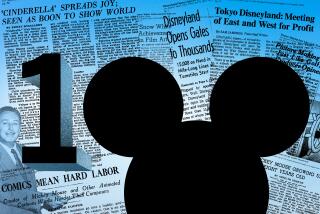That’s Not All, Folks: More Golden Looney Tunes
- Share via
When Mickey, Donald and Goofy get a little too squeaky-clean around the edges, it’s time to rummage around Warner Bros.’ “Looney Tunes” and “Merrie Melodies.”
MGM-UA Home Video’s packaging of the pre-1949 Warners cartoon library has been a bonanza for laser players. Last year, “The Golden Age of Looney Tunes, Vol. 1” (five discs, 70 cartoons, $100) illustrated the art of the Warner Bros. artists from 1933 through 1948.
Now, “The Golden Age of Looney Tunes, Vol. 2” (five discs, 70 cartoons, $100) gathers up more of the brash characters and parodies that poured out of the Warner studios from 1931 through 1948. And, that’s not all, folks. Volume 3 is promised by the end of the year.
Till then, producers George Feltenstein and Jerry Beck chronicle some delightful comic relief in Vol. 2, from the evolution of Bugs Bunny with “Early Wabbits” to developmental Daffy with “The Art of Daffy” (or “Six Directors in Search of a Screwy Duck”).
Some of the studio’s best-known animator-director-producers--Frank Tashlin, Chuck Jones and Bob Clampett--take the spotlight with one disc side devoted to the work of each. Another side features Robert McKimson and Arthur Davis, dubbed “the most neglected talents” from the “Looney Tunes” Golden Age. Think Carol Burnett or “Saturday Night Live” originated film parodies and celebrity takeoffs? Take a look at Clampett’s “Bacall to Arms” or McKimson’s “Hollywood Canine Canteen.”
A side of “Musical Madness,” some of it in black and white or two-strip Technicolor, reveals the inventiveness early animators achieved when forced to use songs from the Warner music library. There’s even “Goopy Geer,” who bears a strong resemblance to the goofy dog from the stable across town.
Some of the groupings may seem a little forced--Side 10’s “Variations on a Theme” (everyone from Elmer Fudd to Porky Pig to Daffy Duck trying to get a few winks). And some are intriguing for their lesser stars--Henery Hawk, Pepe LePew, Sylvester and Tweety Bird among them zip along on Side 9’s “Best Supporting Players.”
There’s a side of “Fables and Fairy Tales” that send up most of the folks Disney is still polishing to a fine gloss, including Aladdin, Beauty and the Beast and Robin Hood.
Clearly, a lot of thought and care has been put into the packaging and handling of these animation treasures. The transfers are free of snaps, crackles and pops. The sparkling, rich colors are crisp and clear. The brochure accompanying the disc is a handsome, informative, puckishly illustrated affair.
But the handling of chapter stops is a mystery. Each side serves up seven cartoons, all nicely titled and numbered 1 through 7. But the discs are programmed by consecutive numbers 1 through 70. So it might help to remember your fourth-grade arithmetic. Want “A-Lad in Bagdad” (No. 3 on Side 7)? Press 45 or you’ll come up blank. If you’re looking for “What Makes Daffy Duck?,” listed as No. 7 on Side 8, seek out No. 56.
Also inescapable as you watch the cartoons evolve through the ‘30s and ‘40s is the pervasive racism of the time. True, cartoons by their very nature are parodies and exaggerations, but stereotypical depictions of blacks and Latinos don’t make for laughs and, in fact, feel quite painful several decades later. Why should Bogey, caricatured in “Bacall to Arms,” be transformed into a gravelly voiced Rochester (Jack Benny’s African-American aide-de-camp) when a cigarette blows up in his face and covers him with soot? It hurts to see some of these golden cartoons tarnished.


